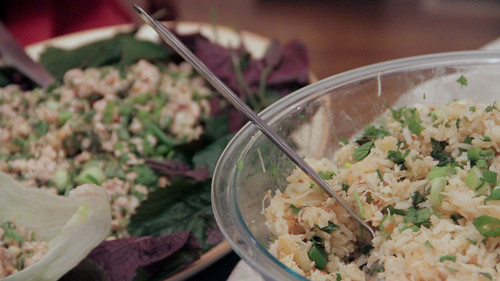 If a lot of this food looks like what you've eaten at a Thai restaurant, it's no mistake. Much of the population of northern Thailand is ethnically Lao, and many "Thai" restaurants in the US are actually run by Lao families, or Isan, which is a term for people in northern Thailand whose language and culture have Lao roots. In fact, the Center for Lao Studies is encouraging "Lao people laying claim to the food that is rightfully theirs." So if you like green papaya salad, sticky rice, or larb, well, you like Lao food!
If a lot of this food looks like what you've eaten at a Thai restaurant, it's no mistake. Much of the population of northern Thailand is ethnically Lao, and many "Thai" restaurants in the US are actually run by Lao families, or Isan, which is a term for people in northern Thailand whose language and culture have Lao roots. In fact, the Center for Lao Studies is encouraging "Lao people laying claim to the food that is rightfully theirs." So if you like green papaya salad, sticky rice, or larb, well, you like Lao food!
(At this point, I should mention that while Lao is the predominant ethnicity, there are several other groups who can be called Laotian, that is, coming from the territory of the country of Laos. Notably, the Hmong are Laotian, but not Lao. I didn't specifically aim for any Hmong or other ethnicities' food in this meal. Also, I by no means mean to imply that all Thai food is of Lao origin, there's a whole universe of amazing food in Thailand that blends influences from all over with local ingenuity and ingredients.)
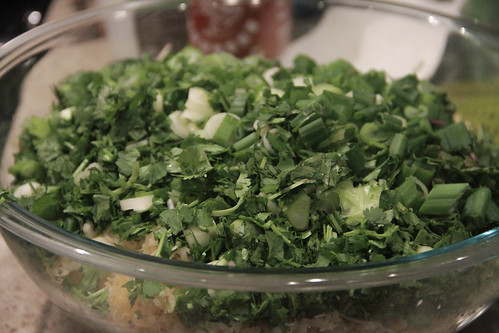
Lao food is a riot of herbs; just about everything is abundantly flavored with super-fresh greens like cilantro, mint, scallion, basil, and a variety of others that barely have English names — seriously, I bought four bunches of cilantro and probably should have gotten more. It's also got a distinctive fish sauce, padaek, which is almost as thick as ketchup and has a richer complexity than the liquid kind seen in Vietnamese and Thai. Recipes didn't specifically call for it, but padaek turned up enough in my research that I felt emboldened to use it. But the number one distinctive aspect of a Lao table is the sticky rice. Laos is the world leader in per-capita consumption of sticky rice, and it's considered an essential part of the Lao experience. Apparently it can also get pretty spicy, but I toned that down quite a lot so the crowd would enjoy the food.
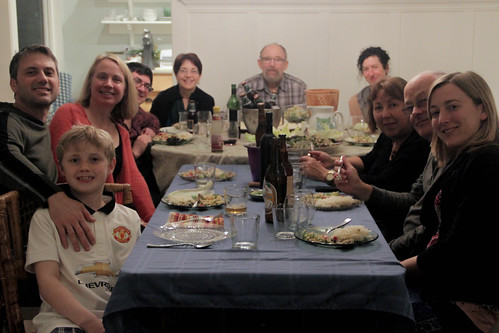
Joining us for this post-holiday meal were our neighbors Chris, Cam, and Colin; my aunt Marcia and her boyfriend Jeff; Deena; and Laura's parents Eileen and Lyall and her sister Jen.
Bia | Beer

Beerlao is probably Laos's best-known export, and it's really pretty good. I'm not sure if I'd go so far as the newspaper review that deemed it the "Dom Perignon of southeast Asian beers," but it's quite satisfying. The dark version's maltiness was a lovely balance to the sour and fishy flavors of the dishes, and apparently it's gluten-free, which I'm assuming means they brew it entirely with rice and no barley. (The standard lager is apparently about 20% rice, and while less flavorful to my tastebuds, certainly satisfying and easy to drink plenty of.) I implied earlier that Thai restaurants show no explicit hint of Lao influence, but that's not quite true — some of them serve Beerlao, and if you see it, I encourage you to try it as a more flavorful alternative to lighter Thai beers.
Larb gai | Chicken and herb salad | Recipe
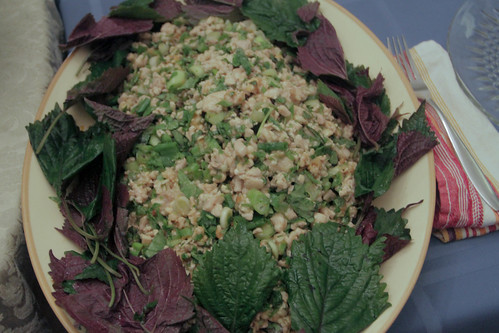
Larb, laap, lahb, lab — it's the Hanukkah of southeast Asian cuisine, what with how many ways there are to transliterate it into English. There's also as many types of meats you can make it with: pork, beef (cooked or raw), fish, and beyond. I went with chicken, as it's a milder flavor that creates a platform for all those other flavors to launch from.
Perhaps foolishly, I decided to hand-chop rather than grind the chicken thighs. Maybe there was a slight difference in texture, but after fifteen minutes with the chef's knife (and regretting several times that I'd gotten rid of my cleaver in the move), I was regretting my choice. The rest of the recipe proceeded nicely, and I was glad that I was able to find all the ingredients, because that little bit of toasted sticky rice powder ended up having a huge impact on the texture and flavor, adding both a rich nuttiness and a little bit of grit to contrast the squeaky chicken and crisp herbs.
The only lettuce I could find was really sad and brown, but fortunately I picked up a bunch of shiso (chrysanthemum) leaves on a lark. They probably don't use those as the taco-like vessel for eating larb, but the leaf's haunting mint-basil-esque flavors sure worked well.
Nam khao | Crispy rice salad | Recipe
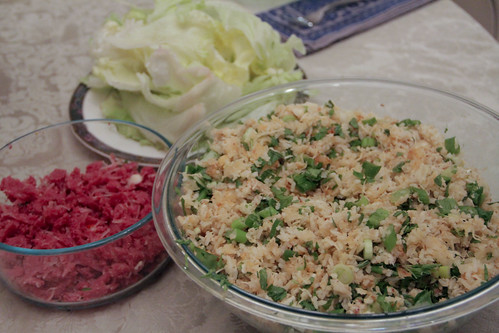
Holy wow, this is a delicious dish. It's a lot of work, but what a payoff! And it introduced me to a brand new food I never new about: sour sausage, a fermented and uncooked — and bright red — pork product, usually called nam or nem in your better-equipped southeast Asian market. (Before you get all grossed out, remember that salami works on the same uncooked-fermentation principle, just for longer until much of the moisture is lost.)
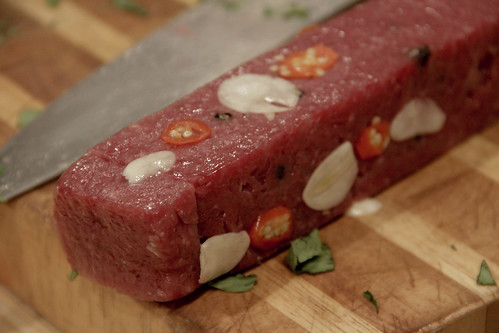
So, once you've made rice and cooled it (or, if you've got leftover rice on hand, so much the easier — turns out you want jasmine and not sticky rice for this one), you mix it with both shredded and powdered coconut, egg, and a bunch of garlic, make it into balls, and fry it to crispy. Then here's where it gets fun: after those fried balls have cooled, you break them up, so some bits are crispy and others are the soft inside, and mix that with herbs, fish sauce, lemon juice, and crumbles of the aforementioned sour sausage. It's a similarly abundant burst of flavors and textures, but in a different direction from the larb, so even though the two are meaty salads, they're certainly different enough to count for variety on the table.
Khao niao | Sticky rice | Recipe
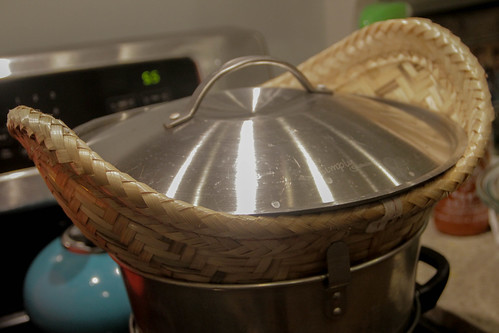
The name I saw in all the recipes was "sticky rice," but when I got to the store, the closest thing I saw was called "sweet rice." It was also labeled in Chinese, Vietnamese, and Hmong, so as I stood in the aisle of Hong Phat Supermarket, I pulled up a PDF scan of a health-practioner's Hmong-English dictionary to verify that what I saw on the package could also be translated as "sticky rice." (Here's what I bought, though I only got 5 pounds.)
I generally make a rule of not buying cooking equipment I'll use only once, but happily I found the proper steaming basket for a mere 2 bucks at another market, so I made an exception. It did require a bit of adaptation to fit over the steaming water, but it turns out the ring from one of those two-part deep cake pans (the kind with the hole in the middle) worked pretty well. I didn't do the flipping right: rather than a single assertive jostle to get the grains on top closer to the steam, I ended up stirring it around, which was slower and less efficient. I think going for five pounds all at once wasn't the right approach, and with so much rice it probably would have benefitted from an overnight soak rather than the 4 hours I afforded. But hey, it turned out tasty. And abundant.
Jeow mak keua | Eggplant dip | Recipe
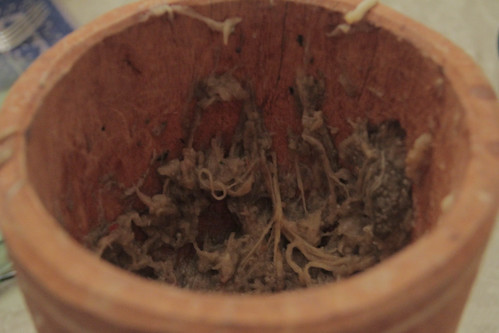
While there's an abundance of fresh herbs in the other dishes, there wasn't anything featuring a vegetable proper, so I took a shot at this eggplant dip. I was also interested to see how the combination of sticky rice and dip would work. It's pretty easy to make this dip, just roast everything, let it cool, peel it, throw in that funky padaek fish sauce, and mash. But, whooo-eee! On first taste, it was really pungent, the uncooked fish sauce overpowering everything. Good thing I made this a bit in advance, because like a complex wine, an hour of breathing allowed it to mellow out and become decent, like a bizarro fishy baba ghannoush, eaten in an equally bizarro manner with little clumps of sticky rice. Not sure if this was the pinnacle of Lao cuisine, and it sure ain't pretty, but it was fun to try.
Tom hua pa | Fish soup | Recipe

This one involved a bit of adaptation. While the recipe says it's for fish heads, I made it with chunks of catfish. And the grocery store didn't have the normal button mushrooms that are probably intended, so you see oyster mushrooms here. Finally, instead of arugula, I opted for watercress, which is also what the store had and what I figured was probably more likely to be what you'd get in Laos.
The soup was tasty enough, with the tang of lime, the trinity of lemongrass, ginger and galangal, and the freshness of herbs, but it was missing depth. And then I realized I forgot to add the padaek, the fish sauce! With a little swirl of sauce, the soup took on a vibrancy and richness that made all the difference.
Khao niao ma muang | Sweetened coconut sticky rice with mango | Recipe

An astute reader will note that there's no mango in this photo. I should have read the writing on the wall when both Asian markets I went to had no mangoes for sale, opting for another option such as banana, but I kept plowing ahead until I found a produce stand with five sad mangoes left. They were terrible, overripe and too starchy at the same time, and went straight to the compost bin.
Fortunately, the rest of the dish was tasty enough to stand on its own. It's really nothing more than a sauce of palm sugar dissolved into warm coconut milk, poured over the rice left from the meal. It was surprisingly reminiscent of the sticky toffee pudding I'd made for Christmas dinner two nights before: thick, rich, and addictive, with a caramel-esque flavor from the palm sugar. A satisfying, and filling, end to one of the better meals of the year!